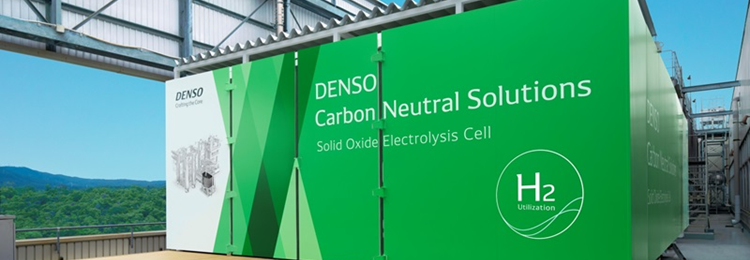
DENSO explores solid oxide electrolysis cell technology to produce green hydrogen
Date: Tuesday 25 July 2023
Through a pilot programme, the DENSO Corporation plans to use a SOEC*1 (Solid Oxide Electrolysis Cell), a device developed by the company that produces green hydrogen through electrolysis of high-temperature steam, to help power and increase the sustainability of its manufacturing operations.
The trial, which will be conducted at DENSO’s Hirose Plant in Japan, will incorporate a verification test using the produced green hydrogen in a prototype power card*2 line and will accelerate the company’s technological developments to achieve carbon neutrality by 2035.
To ensure it meets this goal, DENSO has been actively pursuing initiatives in three key areas: Monozukuri (manufacturing), mobility products and energy use, and the utilisation of hydrogen energy is essential for realising this target, as it does not emit CO2 when burned and can generate significant energy.
To establish a hydrogen supply chain, DENSO is engaging in technology developments related to producing, storing, transporting, and using hydrogen. As part of these efforts, the Hirose Plant, which is the company’s green hydrogen utilisation model factory in the semiconductor manufacturing field, will conduct a verification of green hydrogen production using SOEC technology and its application in manufacturing.
In terms of hydrogen production, DENSO will manufacture hydrogen within the factory using its SOEC, a device that efficiently produces green hydrogen through electrolysis by maintaining a consistent high temperature of around 700°C and incorporates various technologies derived from automotive components, such as thermal management techniques for controlling internal temperatures, ceramic technology for efficient electrolysis at high temperatures, and ejector technology*3 that recycles unreacted steam within the device.
Furthermore, in terms of hydrogen use, green hydrogen produced by the SOEC will be used in the prototype production line for power cards, specifically in the soldering process of assembling the components of the power cards, where hydrogen is traditionally used as a reducing agent to remove solder oxide and improve the joinability. In addition to the existing line that uses externally purchased hydrogen, a new line utilising green hydrogen produced by the SOEC will be established, but both lines will be used simultaneously to verify the stability of production and examine the impact of green hydrogen produced by the SOEC on the quality of power cards.
Initially, the SOEC will utilise externally purchased green electricity as its power source, but in 2025, DENSO plans to start replacing this with its own green electricity generated by solar power generation within the Hirose Plant.
The overall aim of the green hydrogen project is to address the cost challenges associated with transporting hydrogen, by establishing a model of local production and consumption, which involves producing green hydrogen using a SOEC within the factory and consuming it internally, with the intention of integrating the expertise and technology accumulated in semiconductor manufacturing at the Hirose Plant with the knowledge gained from this verification, to eventually applying it to mass production in the future.
Based on the insights and achievements gained from the development of automotive products, DENSO aims to continue exploring the potential of green hydrogen in the manufacturing field and contribute to the creation of a carbon neutral society.
*1 SOEC (Solid Oxide Electrolysis Cell): A device that operates at high temperatures using a ceramic membrane as an electrolyte to electrolyse water vapour and produce hydrogen. While there are other methods for hydrogen production, such as alkaline water electrolysis, which uses an alkaline liquid as the electrolyte, and PEM (Proton Exchange Membrane) water electrolysis, which uses a polymer membrane as the electrolyte, the SOEC used in this verification has the advantage of requiring less electrical energy for electrolysis compared to these other methods. However, since March 2023, DENSO Fukushima Corporation and Toyota Motor Corporation have been conducting a joint verification using PEM water electrolysis devices.
*2 Power Card: A component of an inverter that drives the motor in hybrid or electric vehicles. This product controls the inverter by rapidly switching the power on and off, leading to enhanced fuel efficiency and energy conservation.
*3 Ejector Technology: A technology that recirculates discharged water vapour within the equipment.
References
For more information about DENSO’s efforts to achieve carbon neutrality, please visit “DRIVEN BASE,” which is part of DENSO’s website, to read the following articles:
- Overcoming obstacles to the achievement of a hydrogen society, a star of hope for decarbonisation:
https://www.DENSO.com/global/en/driven-base/project/hydrogen_society/ - DENSO is challenging itself to develop a solid oxide electrolysis cell system looking ahead to a future of hydrogen society: https://www.DENSO.com/global/en/driven-base/tech-design/soec/
- Thoroughly eliminating inefficiencies through seamless wevelopment from materials to systems -DENSO’s initiative to develop SOEC systems, which are indispensable for creating a hydrogen society:
https://www.DENSO.com/global/en/news/newsroom/2023/20230519_g02/
Further details of the DENSO Aftermarket programme are available online at: www.denso-am.eu
